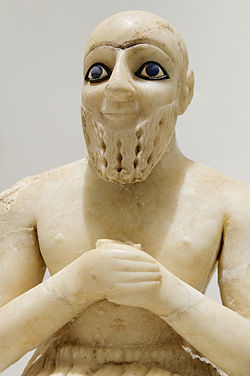Statue of Ebih-Il: Difference between revisions
No edit summary |
No edit summary |
||
| Line 24: | Line 24: | ||
==Excavation== |
==Excavation== |
||
The statue was discovered in two parts by the French excavation team under Andre Parrot.<ref name=Ebih>Cluzan; Lecomte, 2011, p. 5.</ref> The head was found on the pavement of the outer court of the Temple of Ishtar on 22 January 1934.<ref>Parrot, 1935, p. 26-27.</ref> The body, along with the smaller statue of King Išgi-Mari, was found a few meters away, the next day.<ref name=Ebih/> The statues was the first major discovery in the excavations, started in Winter 1933, at the site of Mari.<ref>Parrot, 1935, p. 1.</ref> |
|||
==References== |
==References== |
||
===Citations=== |
===Citations=== |
||
===Bibliography=== |
===Bibliography=== |
||
{{refbegin}} |
{{refbegin}} |
||
{{cite book|first1=Sophie|last1=Cluzan|first2=Camille|last2=Lecompte|first3=|last3=Musée du Louvre. Département des antiquités orientales|title=Ebih-Il|isbn=9782757205099|publisher=Louvre éditions|year=2011|place=Paris|language=French}} |
*{{cite book|first1=Sophie|last1=Cluzan|first2=Camille|last2=Lecompte|first3=|last3=Musée du Louvre. Département des antiquités orientales|title=Ebih-Il|isbn=9782757205099|publisher=Louvre éditions|year=2011|place=Paris|language=French}} |
||
{{refend}} |
{{refend}} |
||
[[fr:Ebih-Il]] |
[[fr:Ebih-Il]] |
||
Revision as of 16:55, 10 October 2012
| Statue of Ebih-Il | |
|---|---|
 Statue of Ebih-Il, superintendent of Mari | |
 | |
| Material | Gypsum, lapis lazuli, shell |
| Height | 52.5 centimetres (20.7 in) |
| Width | 20.6 centimetres (8.1 in) |
| Depth | 30 centimetres (12 in) |
| Created | c. 2400 BC |
| Period/culture | Archaic Dynasties |
| Discovered | 1934–1935 |
| Place | Temple of Ishtar, Mari, Syria |
| Present location | Musée du Louvre, Paris |
| Identification | AO 17551 |
The Statue of Ebih-Il is a 25th-century BC statue of the praying figure of Ebih-Il, superintendent of the ancient city-state of Mari in eastern Syria. The statue was discovered at the Temple of Ishtar in Mari by French archaeologist Andre Parrot. It is made of gypsum, with inlays of lapis lazuli and shells. Iselin Claire of the Musée du Louvre, where the statue is displayed, describes it as "a masterpiece by virtue of its craftsmanship, state of preservation, and expressive style."
Overview
Ebih-Il
Excavation
The statue was discovered in two parts by the French excavation team under Andre Parrot.[1] The head was found on the pavement of the outer court of the Temple of Ishtar on 22 January 1934.[2] The body, along with the smaller statue of King Išgi-Mari, was found a few meters away, the next day.[1] The statues was the first major discovery in the excavations, started in Winter 1933, at the site of Mari.[3]
References
Citations
Bibliography
- Cluzan, Sophie; Lecompte, Camille; Musée du Louvre. Département des antiquités orientales (2011). Ebih-Il (in French). Paris: Louvre éditions. ISBN 9782757205099.
